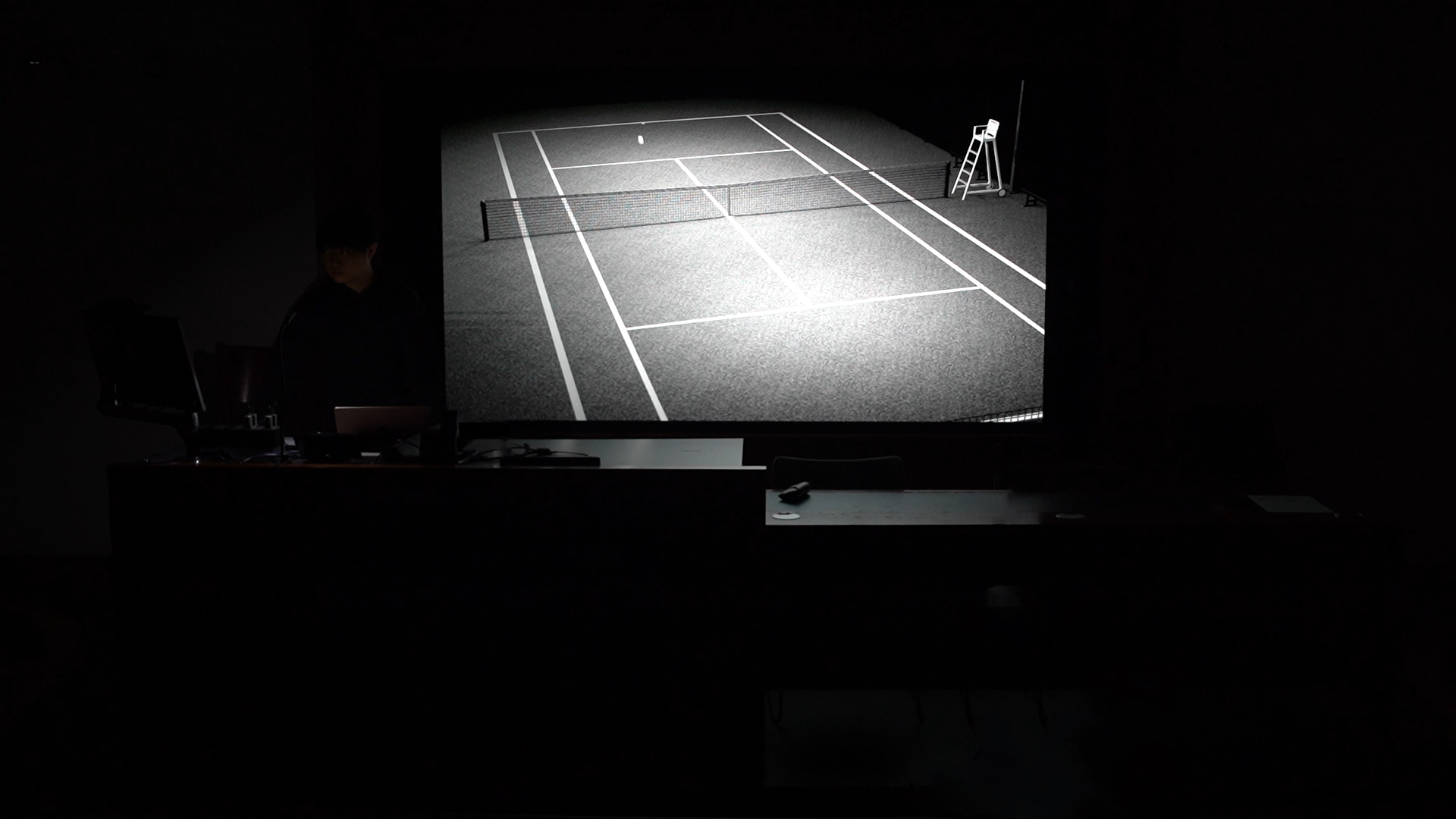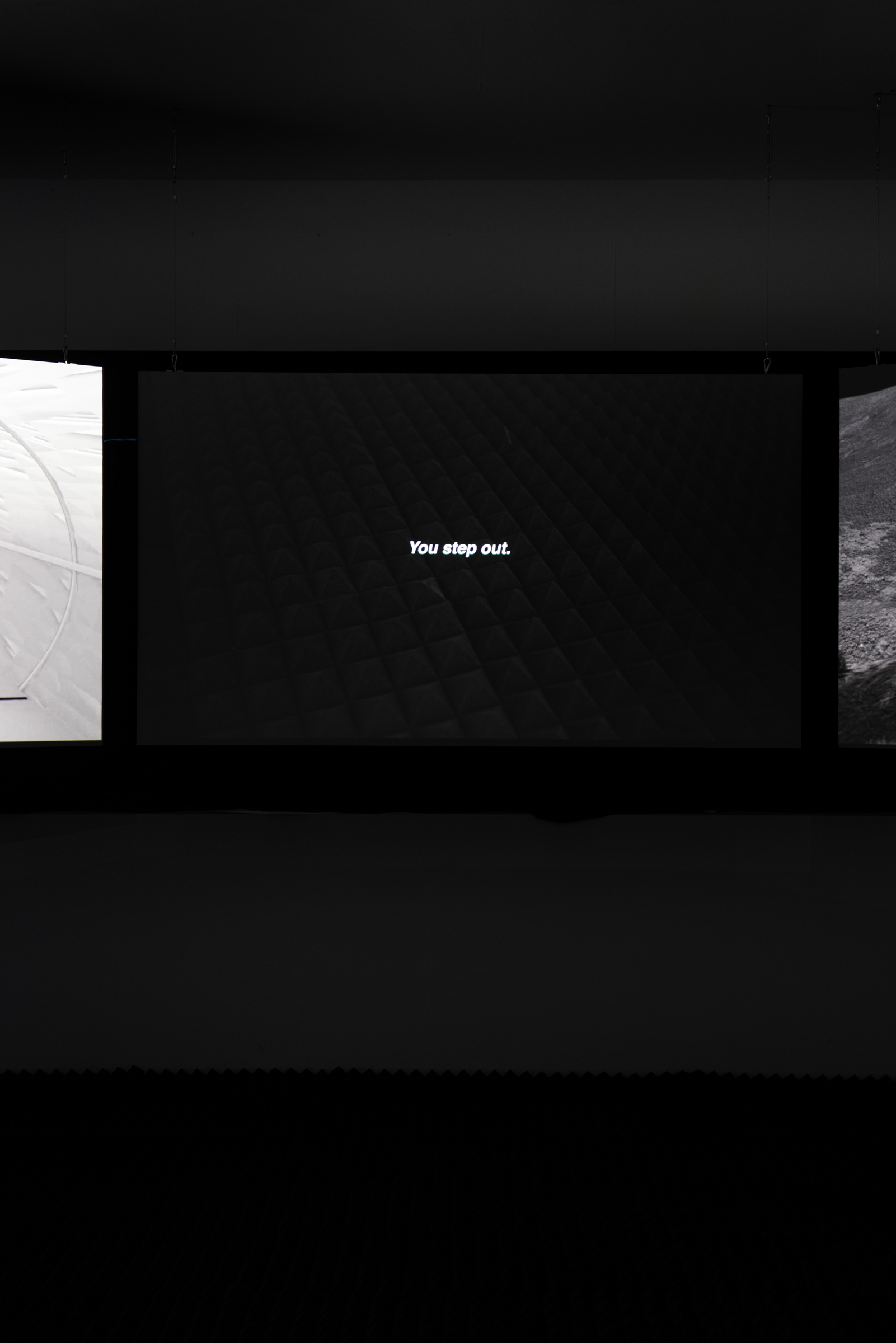
Cinephile Spiral, 2025, Lecture performance with video installation
Cinephile Spiral is a 10-minute lecture performance with a moving image installation that traces a journey from London to Macau to Hong Kong through three films: Blow-Up, The Longest Nite, and Happy Together. Beginning with a British film made by an Italian director, it questions authorship, territory, and cinematic memory through a decolonial and diasporic lens. Using fragments of film, sound, and text, the work explores migration, deferred futures, and the repetitions of postcolonial histories. It reflects on what it means to see, remember, and belong as an Asian within the former imperial centre.
-

Structure(s) , 2025, HD video
Structure(s) traces architectural memory across imperial spectacle and migrant presence. From a rendered reconstruction of the 1924 Wembley Empire Stadium to the red bricks and green-tiled roof of Wing Yip supermarket, the video essay weaves official and unofficial histories through voice, image, and spatial form. Archival material from the Hong Kong Pavilion at the British Empire Exhibition resurfaces as a ghost structure, linking past displays of “Chineseness” to contemporary diasporic sites. An accompanying mind map renders these fragments as a network of architectural meaning — where surfaces speak, and identities are layered, performed, and remembered.
-




Artha, 2024-25, Three Channel Projection Installation (Photo: Wenxuan Wang)
Artha, that renders and reinterprets key moments from Andrei Tarkovsky and Werner Herzog’s films. The left channel draws on Tarkovsky’s Stalker, depicting surreal, desolate landscapes that represent the invisible boundaries of exile. The animation mirrors the stillness and ambiguity of the Zone, presenting a terrain where past and present intersect in a space defined by both hope and despair.
The right channel reimagines Herzog’s Auguirre, the Wrath of God, transforming its relentless river journey into a chaotic, dreamlike flow. The animation reflects the historical struggles of displaced peoples navigating colonial violence, framing Aguirre’s doomed quest as a metaphor for exile, ambition, and loss. The centre channel sees displacement as no longer tied to any specific geography but as a universal, fluid condition. It reflects the internal experience of diaspora - fragmentation, memory, and the search for belonging in an unfamiliar world.
The darkened gallery not only resembles the room in Stalker - a space of yearning and unfulfilled desires - but, through the acoustic insulation lining the gallery floor, absorbs footsteps and amplifies a pervasive sense of solitude, or the psychological weight of diasporic experience, as if the room itself holds the accumulated memories and silenced histories of those in exile.

No Direction Home, Blowin’ in the Wind, 2024, AV installation (Photo: Wenxuan Wang)
The fan’s persistent breeze stirs these images into a state of drift, blurring the boundary between presence and loss. Together, the installation becomes a fragile, suspended meditation on diasporic identity, where home is not a fixed point but a space between recognition and forgetting, culture and estrangement.

This is better than Disneyland!, 2025, two channel video installation (Photo: Wenxuan Wang)
Beneath these burning emblems, the presence of candles, quiet, sacred, perishable, offers an intimate counterpoint. Fire in this work is layered: industrial, mythic, spiritual. Like Prometheus’s gift, it is both illumination and destruction. The installation becomes a haunted meditation on the aesthetics of war, the seduction of imperial symbols, and the uneasy flicker between innocence and devastation.
-

Séance II: The Arrival of a Train to Orson Welles, 2024, lecture performance with moving image installation
A lecture-performance, I weave together rendered images and historical analysis to trace the evolution of stereoscopic imagery. A central element of the performance connects to Orson Welles’s unfinished epic, Don Quixote, highlighting the fragmented layers of lost and incomplete cinema. This work seeks to investigate the complex interplay of memory, myth, and the forgotten narratives within cinematic history.

Séance I: Bake Jizo, 2023, video
Through the process of re-reading the very beginning of Asia’s film history, we discover that the ghost has disappeared. Meanwhile, obsolete technologies have become dead media, and artists are tracing the ghostly illusion of the image from these obsolete technologies. By combining archives, video, and 3D rendering, artists attempt to explore the ambiguity of historical and material memories.

Séance IB: avatars, 2023, video
-

Sekaikei, 2022, two channel video installation
Sekaikei (2022) is a two-channel video that navigates the blurred terrain between apocalyptic imagination and digital reproduction. Borrowing its title from a Japanese term that fuses personal emotion with global crisis, Sekaikei examines the dissolution of grand narratives in the face of fragmented, data-driven world-making. Drawing from Hiroki Azuma’s theory of “Database Animals” and Eiji Otsuka’s critique of narrative structure, the work reflects on how identity, community, and meaning are constructed in the aftermath of cultural collapse.
Narrated using the script of the final episode of Neon Genesis Evangelion (1995), the work contemplates how new worlds are generated, through memory, emotion, and the default architectures of software. Built with Cinema 4D and Blender, Sekaikei dissects the visual grammar of game engines and rendering tools, exploring how technological layers mimic and distort reality. It probes the aesthetics of the “default”: standardised skies, prefab terrains, virtual bodies, as both limit and potential in image production.
Rooted in diasporic estrangement, the work proposes “nomadalgia” in place of nostalgia: a persistent longing without origin or return. Sekaikei unfolds as a digital elegy, where database fragments form a landscape of crisis, desire, and deferred belonging.
-

Neither/Nor, 2021, video
"Neither/Nor" (previous title: Wandering With Spirit) is a crisis about identity. Virtual network created a borrowed place on borrowed time, to reveals the options unlocked by a state of ‘in-betweenness’ – in-between ethnicities, borders and hyperreality. Only through discovering the relational ties with places to identify the ‘situation’ we are drawn into and perceive our own ‘presence’. "Neither/Nor" is questioning the fragmentized narrative embedded through various types of reconnections.